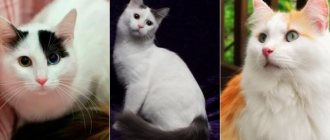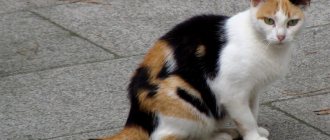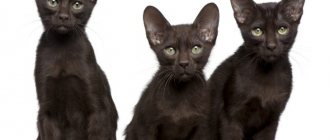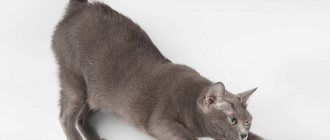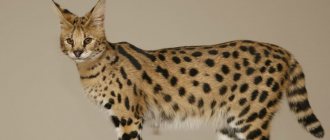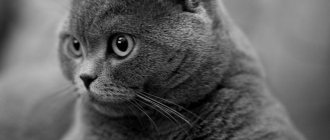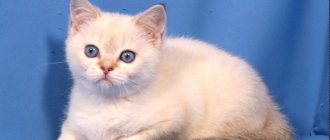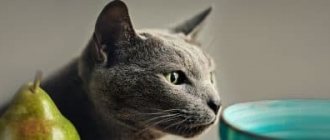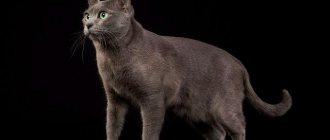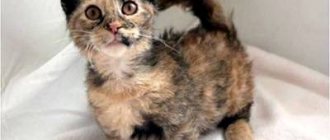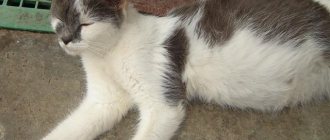The Turkish Angora cat is a graceful, elegant animal with good flexibility. This breed can be called one of the oldest, the first representatives of which appeared on the territory of modern Turkey and Iran.
The name itself, Turkish Angora, comes from the name of the capital of this state - Ankara. A gene mutation that endowed animals with especially fluffy fur occurred in cats living in the Caucasus. They became the progenitors of modern representatives of the breed.
Turkish Angora cat.
Description and accepted standards
This breed has long slender legs. The eyes should be almond-shaped. The Turkish cat must have:
- Head. Can be of different sizes, from small to medium, depending on body size. The shape is in the form of a regular wedge, of medium length. The profile has two planes formed by the top of the head and the nose line, which intersects above eye level.
- Muzzle. It is a continuation of the wedge lines; there should be no bulges.
- Ears. Large, with a wide base, sharp tips, and a little fluff on the inner surface.
- Eyes. Large in size, almond-shaped, slightly slanted, wide open. Eye color does not depend on coat color and can be of any color.
- Nose. Should be of medium length.
- Neck. slender, thin, long.
- Chin. Curved and strong.
- Body. It is of medium size and correct proportions. The skeleton is strong, the body itself is long and slender. The sacrum is located above the line of the shoulders.
- Legs. The rear ones should be longer than the front ones.
- Tail. Long, pointed with a wide base and narrow end.
The hind legs may look like pants. The balance of the physique should be proportional. The presence of disproportions in physique is not allowed; stocky individuals, with kinks in the tail, and with pronounced strabismus are subject to disqualification. The size and weight of Angora cats correspond to medium-sized cats - 3.5-5 kg. The table below shows the weight of kittens of this breed from one month to two years.
Turkish Angora weight table by month.
Material on the topic: popular colors of the Scottish cat breed.
Coat colors and features
This breed has a guard coat and no undercoat. The length of the hair varies along the length of the animal. On the collar and tail it is longer and silky. The color of the coat can be very different:
- White. The white angora is the most common cat. The color should be uniform, without any inclusions.
- Black. It has a coal-black, shiny hue. The color is uniform along the entire length of the hair. The leather is also painted black.
- Blue. It can be blue or lighter shades. The shade should be uniform over the entire surface.
- Cream. The shade is even, without spots or inclusions. Light shades are more preferable.
- Red. The color is deep and rich. No shading or marks.
- Smoky black. Has a white undercoat. Outwardly, the cat looks black, but when it moves, white fur is visible.
- Smoky blue. Similar to black smoke.
- Tabby. The drawing is expressed against a general background. There is a clear letter M on the forehead.
There may be other colors besides chocolate, lilac or Himalayan colors or their combinations with white.
Black and white Angora cat.
Red Angora cat
Red and white colors
Breed subspecies
There are different subspecies that have different standards established by international felinological standards - WCF, CFA, TICA, FIFE.
Care and maintenance
The Turkish Angora cat breed is not just an animal with a chic snow-white color. This is also a very easy-to-care pet that will feel happy in almost any conditions. When you decide to get yourself a four-legged affectionate friend, remember a few simple rules for caring for him:
- The Angora's diet must be balanced - the cat has a sensitive stomach, so it is highly not recommended to feed it from the table. To prevent the snow-white color of the coat from turning yellow, you need to exclude products with active pigments from the animal’s menu - liver, seaweed, hearts;
- You can comb your pet once a week, because the fur has virtually no undercoat, so it doesn’t get tangled;
- it is necessary to pay special attention to eye care - they should be wiped with special lotions;
- trim nails regularly and clean your pet's ears;
- It is imperative to carry out routine vaccination and deworming.
Combing
Angora cats are brushed using a special brush with an antistatic coating - this device is called a furminator. Representatives of this breed tolerate brushing well. It is better to start scratching the fur in the direction from the head to the tail, and then move on to the stomach and paws. The procedure can be performed 1-2 times a week, during the molting period - 2-3 times.
Bathing a kitten
The Angora cat loves to bathe, but only special cat shampoos should be used for washing. Snow-white individuals are often bathed somewhat more often than cats of other colors - 1-2 times a month. It should be remembered that human shampoos are contraindicated for Angora dogs - the substances contained in them can cause harm to the animal’s fur and skin.
Teeth and eye care
Animals' teeth are brushed several times a week, using a brush and special toothpaste. If tartar appears, it is recommended to immediately contact a veterinary clinic to have it removed. If necessary, discharge from the eyes of the Angora beauty is removed using a cotton pad moistened with warm boiled water. It is important to regularly examine and treat your pet’s ears: the shells are cleaned with a cotton swab soaked in liquid Vaseline, followed by the use of hydrogen peroxide, which is applied to the skin in the same way.
Toys and scratching post
Representatives of the Angora breed need exercise, so when you bring a new resident into your home, it is better to install a cat play set for him. Don't forget about playing together with your pet. Suitable toys for the Angora include teasers, balls, toy mice, feathers, etc. A scratching post is also an essential attribute in an apartment where there is an Angora - the animal will sharpen its claws with its help, rather than using sofas, door frames and other furniture for these purposes. .
Character of the Turkish Angora
The Turkish cat is distinguished by restraint, high intelligence, and activity. This breed is also affectionate and gets along well with people, children, and other animals living in the apartment. Shyness is not typical for them, they love to spend their time next to their owner. When guests arrive, they may hide in a secluded place for a while, but then they will still go and get acquainted with them.
Angora talkativeness is rare. These cats are attentive and observant. They easily remember how the doors of cabinets, refrigerators and other movements of the owner open, which they then repeat to the best of their physical abilities.
If the owner hid his favorite toy from her, the cat will certainly find it and make every effort to get it back. They are good at capturing the intonations in the voice, the change in mood of a person, especially their loved one.
Turkish breed cat.
Diet selection
Any cat can receive two types of food - ready-made and natural. First, you should choose food from a professional line that has a high-quality, balanced composition. This food is made from meat, vegetables, grains, and has added minerals, vitamins and other substances necessary for the body. Natural nutrition should not consist of food from the human table. Such food can harm the health of the animal. An Angora cat's diet should not contain:
- fatty meat;
- sausages, sausages;
- smoked products;
- spices;
- sweet.
It is not recommended to give white animals liver or heart, or sea fish. In this case, there is a risk that the wool will acquire a yellow tint.
Food for this breed should consist of:
- boiled or frozen meat;
- fermented milk products – kefir, cottage cheese;
- raw vegetables, fresh herbs;
- cereal porridge.
It is advisable to give your cat sprouted oats, as their wild counterparts eat fresh grass. At home, there is no such opportunity; this is why such crops are sprouted. The animal must also have constant access to water.
Shelf for cats
Health and illness
These animals have an average life expectancy of 15-17 years, there are individuals that live up to 25 years.
The Angora breed itself is native and therefore enjoys good health. They rarely have genetic diseases, and frequent visits to veterinarians are not their thing. Health problems are often associated with improper care or nutrition. The only phenomenon that occurs in these animals is congenital deafness. This affects not only white individuals, but any individual. To avoid this, professional breeders do not resort to crossing two white cats. This is considered bad manners. If, after all, kittens have already appeared with such a feature, this is not a reason to be upset. Such an animal requires more attention from humans; it should not be allowed to roam freely on the street. The lack of hearing is compensated by more developed other senses - vision, instinct, intuition. Timely vaccination is mandatory for all animals.
Vaccinations and prevention
Immunity in newborn kittens is formed thanks to mother's milk. The first vaccinations are given by the breeder himself at the age of two months - these are vaccines against calcivirosis, panleukopenia, and rhinotracheitis.
Question to the expert
At what age are Turkish Angora vaccinations given?
Rabies should be vaccinated at 12 weeks, followed by a second vaccination about a month later. It is recommended to use the same drug. Adults also have a chance of getting sick. The vaccine provides protection against diseases, but only for a while, and then it is repeated.
Castration and sterilization
If the Turkish cat is not planned to be adopted by the owner for breeding, veterinarians recommend castration. Sterilization and castration are fundamentally different operations. The first completely deprives the animal of the function of childbearing.
It is possible to remove the gonads as early as two months of age, as other surgical methods are now used. The laparoscopic method of performing the operation has found widespread use. After this, the animal needs special care. Also, such individuals are more susceptible to gaining excess weight, so it is necessary to follow a special diet so as not to provoke obesity.
Comparison table: pros and cons of the Van breed
| Characteristic | pros | Minuses |
| Appearance | Extraordinarily beautiful eyes, soft fur | Due to spotting, you can “run into” a mongrel cat with spots |
| Character | Intelligent cat, loves her owner, capable of learning, gets along well with children | Scares dogs, occupies the highest points in the house, willful |
| Content Features | Can adapt to almost any proposed conditions | Need a lot of toys, frequent play, walks and bathing |
| Appearance care | Due to the lack of undercoat, you don’t have to comb it often, the wool doesn’t get dirty | You need to brush your teeth often |
| Health | Good health, no predisposition to diseases | Your teeth may hurt |
| Breeding Features | May give birth frequently | Sometimes there are complications associated with childbirth |
| Kitten price | There is a chance to find a Van kitten thrown into the street | Van is considered one of the most expensive purebred cats (included in the Forbes list) |
| Owner recommendations | I like the appearance, ease of maintenance and character of the animal | Few owners are bothered by unusual behavior |
Breeding Turkish Angora
The main condition for breeding this breed is the ideal state of health and appearance of the individual. You must have all the necessary documents and pedigree for your pet. Only when you have it in hand can you start looking for a mating partner.
How to choose a kitten
You should choose a kitten with special care and caution. There are significant risks of getting an outbred animal that will only partially look like the Angora breed.
Unscrupulous breeders offer white, non-purebred Persians, passing them off as the ones they are looking for. You should seek the help of a specialist in the field of felinology, who can accurately distinguish purebred individuals from half-breeds. To make the right choice, there are several rules that are important to know before visiting the nursery:
- You cannot purchase a kitten under 12 weeks old. Such kittens are still weak and must be breastfed naturally. Moving to a new place will be a serious challenge for them.
- Be sure to have your kitten examined. It should not have an unpleasant odor, the coat should be clean, and there should be no discharge on the eyes or ears.
- The belly must be soft, otherwise there is a possibility that the animal is infected with parasites.
- Together with the baby, the owner receives his veterinary documents, pedigree, registered in the official breeders club.
The passport contains notes about vaccinations that were carried out at 9 and 11 weeks. If this condition is violated, you should not purchase such kittens. Many breeders sign a sales contract only on mutual conditions that the new owner will subsequently sterilize his pet.
How much does a Turkish Angora cost?
The average cost of a purebred kitten, depending on its class, can cost from 5,000 to 30,000 rubles. There are quite a lot of professional nurseries and breeders in our country; finding a suitable animal will not be difficult. After the purchase, the question arises of what to name a Turkish Angora kitten. The table below shows popular names, among which it is easy to choose the right one.
Table of popular names for Turkish Angora.
Pregnancy and mating
Mating can be carried out only after her body becomes ready for this. Typically, breeders or catteries use cats after the third or even fourth mating. That is, after about the first year of life. This condition also applies to males. Pregnancy in an animal lasts on average 65 days. Usually the birth itself is not accompanied by difficulties, so if there are no special indications, there is no point in taking the “mommy” to the veterinary clinic.
Interesting read: everything about the Balinese breed.
Origin story
Cats with semi-long hair and white or light color came to Europe back in the 16th century from Byzantium (according to some sources in the 14th century). The cats were called Angora in honor of the city of Angora, which today is called Ankara and is the capital of Turkey. They were very popular in Russia and then in Europe, so much so that all white cats with long or semi-long hair were called Angoras.
This is the oldest breed known today, descending from the very first domesticated African wild cats. Initially, they were short-haired, then a mutation occurred, as a result of which individuals with semi-long and long hair appeared.
For 100 years (since 1917), Turkey has been implementing a program aimed at preserving the snow-white Angora cat with different eyes (blue and amber), which is considered the country’s national treasure. The fact is that at one time the Turkish Angora was on the verge of extinction, and the decision to preserve the breed was made by the country's authorities at the highest level.
This state of affairs is due to the fact that at the end of the 19th century, English felinologists decided to unite all breeds of long-haired cats into one group. It included Persians, Angora and Siberian cats. Angoroks were mainly used for mating with Persians, to improve the characteristics of the latter's wool. As a result, the fur of Persian cats acquired the necessary qualities, and the Angora cat became a huge rarity, even in its homeland, Turkey.
A center was created at the Ankara Zoo, where specialists began breeding snow-white Angora cats; a mandatory condition was the blue color of the iris (heterochromic color was allowed).
It is interesting that in Russia Angora cats have always remained quite popular; they have never been used en masse to improve the qualities of other breeds, so they have not become rare. And today in our country there are enough nurseries and breeders of these cats, so purchasing a kitten will not be difficult.
In the mid-20th century, breeders from Europe and America began to develop the breed, using as a basis several individuals they obtained from the Ankara Zoo. The standards were registered in 1973, since then Angora cats have been gradually recognized by all major felinological organizations, with the exception of the GCCF.
Today, everything unusual is popular, people want to buy something exclusive, and there are fewer and fewer snow-white Angoras. They are inferior to cats with other colors, the number of which is constantly increasing.
Interesting facts about the breed
The Turkish cat has many different interesting stories from her biography. There are many paintings from the 17th to 19th centuries depicting these animals. They were on the canvases of Bouchelier, Hayer, Ware and other artists of that time. This cat became the main character of Marshak’s work “Cat House”. Among the fans were many famous people, from Cardinal Reshelier to poets, artists, and fashion designers.
Adult cat
